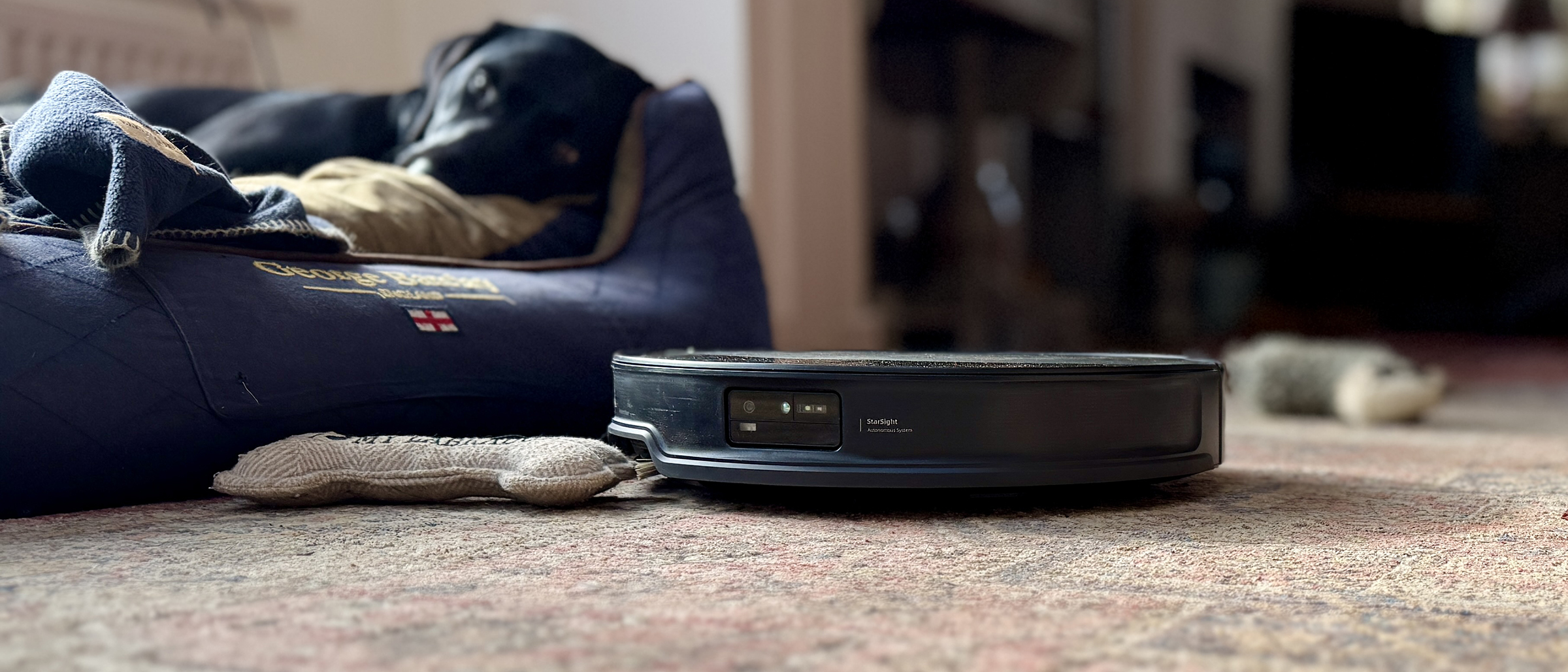TechRadar Verdict
The Roborock Saros 10R is the perfect hybrid robot vacuum for even the most cluttered of homes. With its brand new solid-state LiDAR navigation system, slim sub-8cm stature, excellent suction power and very decent mopping, this autonomous house bot goes where others fear to tread. All that, plus its unique tangle-free roller system is especially deft at dealing with pet hair. Highly recommended.
Pros
- +
Innovative and effective navigation system
- +
Low-profile – no raised puck
- +
Exceptional vacuum performance
- +
Extremely quiet
- +
Great at handling pet hair
- +
Dock looks smart
- +
Very capable dock
Cons
- -
Premium price
- -
Overkill for some needs
Why you can trust TechRadar
Roborock Saros 10R: two-minute review
The Roborock Saros 10R is one of Roborock's 2025 flagship models, and proof if we needed it that robot vacuum cleaner innovation is advancing at a truly blistering pace.
Yes, the Saros 10R is expensive ($1,599.99), but that's the price you'll pay for any premium robot vac, especially when it's from one of the best robot vacuum brands around; Roborock is well known for consistently pushing the envelope of robot vac design, innovation and reliability.
This new flagship model can be considered a direct successor to the popular S8 MaxV Ultra and is available in two variants, the Saros 10R I'm reviewing here, which is equipped with a new type of Solid-State LiDAR that doesn't require a turret, and the cheaper Saros 10 which uses a retractable turret.
All you really need to know is that the Saros 10R is squat enough to zip under furnishings just 8cm in height while sporting a gorgeous looking mirrored glass dock, oodles of suction power, revolutionary StarSight LiDAR navigation and mapping, plus a fully integrated mopping system with full self-cleaning facilities.
If you have a cluttered home with a complex layout, lots of furniture and a surfeit of messy kids and pets in tow, this is the model – this autonomous household helper does pretty much everything but make the tea. That's the short version; read on for my full Roborock Saros 10R review.
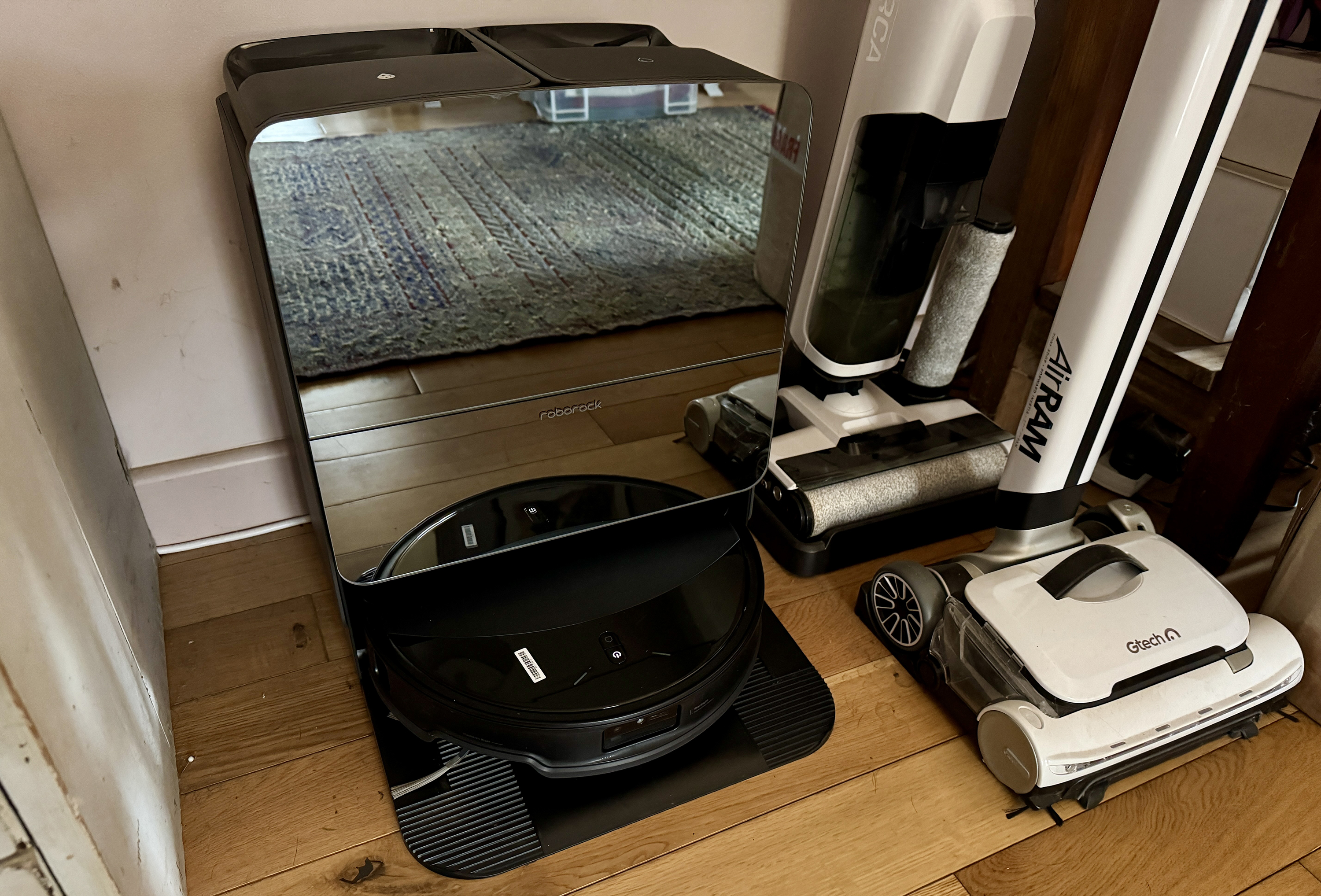
Roborock Saros 10R review: price & availability
- List price: $1,599.99
- Launched: February 2025
- Available: US
Although robot vac prices have generally dropped in price while offering far more tech for your money, the very latest premium models will always cost in excess of a grand, at least for the first few months of their shelf lives. That's certainly true of the new Roborock Saros 10R which retails at an eye-watering $1,599.99.
Yes, there are other high-end bots out there that offer generally similar performance to the Saros 10R – the Dreame L40 Ultra for instance – but I haven't come across another model that does quite as much as this one, including its ability to negotiate the deeper recesses of the home.
The Saros 10R launched in February 2025 and is available in the US only. At time of updating this article, this model is also scheduled to go on sale in the UK, although we don't know when or how much it'll cost. Assuming it's roughly the same price in pounds as it is in dollars, it would be around £1,290.
If you live in the US, you can purchase the Saros 10R direct from Roborock, or via Amazon. Best Buy also sells Roborock robovacs, so it may also become available there.
- Value for money score: 4 out of 5
Roborock Saros 10R specs
Max suction: | 20,000Pa |
Robot size (W x D): | 13.8 x 13.9" / 35 x 35.3cm |
Robot height: | 3.1" / 8cm |
Dock dimensions (W x D x H): | 18.7 x 15 x 19.2" / 47. 5 x 38.1 x 48.8cm |
Dust bin volume (dock): | 2L |
Water tank volume (dock): | 3L clean, 3L dirty |
Base type: | Charge, empty dust, heated mop washing, hot-air mop drying |
Highest noise level: | 62dB at source / 55dB at 10 feet |
Roborock Saros 10R review: design
- Impressive vacuum and mopping features
- Extremely stylish mirrored dock
- Expert navigation, mapping and obstacle avoidance
Most robovacs these days are equipped with a LiDAR turret that protrudes about half-an-inch above the body of the bot. This not only makes the robot look a bit ugly but, more than that, it prevents the bot from passing under low-slung furniture like cabinets and some sofas and beds.
By stark contrast, this stunning, black-only hybrid model from Roborock eschews a turreted LiDAR in favour of a flush, newfangled solid-state LiDAR navigation system (as opposed to rotating LiDAR, where the laser beam rotated 360-degrees). This not only takes navigation performance to a whole new level, but also allows the robot to venture beneath furniture with just an 8cm gap to the floor.
In fact, at just 3.14" (7.98cm) in height, the Saros 10R is the first robot vacuum I've ever tested to make it under my TV cabinet with just one millimetre of clearance. What's more, having a robot vac with no LiDAR turret means no more issues of a spinning LiDAR module sticking on a loose strand of pet hair – it happens. And of course, it also gives the unit a much more sleek and stylish appearance.
Navigation features
Aside from raw suction power and overall cleaning performance, a robot vac is only as good as its navigation system. As alluded to above, the majority of modern robots use two-dimensional LDS (Laser Distance Sensor) LiDAR and it serves them well. However, Roborock has thrown that book out of the window and has equipped this model with StarSight Autonomous System 2.0, a Dual Transmitter Solid-State LiDAR system that offers '3D Time-of-Flight scanning of the home for expert navigation around and under low-lying furniture, and enhanced mapping by capturing detailed height and depth information'. I'll take that, whatever it means.
The Saros 10R also features front-mounted RGB and infrared cameras for high-resolution visual recognition, side-mounted VertiBeam Lateral Obstacle Avoidance for moving around irregular-shaped furniture, walls and unfurled cables, and a front-mounted LED headlight for improved navigation in dark spaces. There is also another infrared camera and transmitter on the rear, plus the usual array of downward-facing drop sensors to stop it from falling down a flight of stairs, no matter which way it's facing. (Here's more on how robot vacuums navigate.)
To give you some idea of how far ahead of the game this robot's LiDAR system is, Roborock says that its 3D StarSight LiDAR system produces over 21,600 sensor points as opposed to standard two-dimensional LDS LiDAR, which produces just one. Consequently, this potpourri of navigation systems makes the Saros 10R ideal for cluttered homes with irregular layouts, a surfeit of furnishings and a lot of obstructions like toys, shoes and other household items. As of writing, the Saros 10R's obstacle avoidance system can recognise up to 108 household objects.
Bot design
That's Roborock's pioneering navigation system out of the way, so let's take a look at the mechanical stuff starting with this model's suction power. According to Roborock, this model sports 20,000 Pascals of 'HyperForce' suction power and that's about as strong as it currently gets (the upcoming Eureka J15 Max Ultra will apparently offer 22,000Pa, but that's the highest we've seen). It means its suction will reach deep down into medium and deep-pile carpet, removing a lot of obstreperous dust particles in the process. This model also includes a feature called DirTec that automatically increases vacuum power whenever heavy soiling is detected.
I should point out that raw suction power alone isn't the be-all and end-all of a vacuum cleaner's performance, since much of the work is also performed by the brush roller. And I think Roborock has nailed it with its DuoDivide anti-tangle main brush – a rubber two-piece corkscrew design that shuffles pet hair towards the centre where it's instantly sucked into the robot's slightly larger-than-average 270ml internal bin. This brush head will also raise by a few centimeters when heading to and from the dock to avoid any unnecessary contact with the floor.
Along with the main brush bar, the Saros 10R is also fitted with an anti-tangle side sweeping brush that pops out of the side by a couple of inches so it can reach into corners and around furniture legs. This side brush also lifts when not required, like when on carpet.
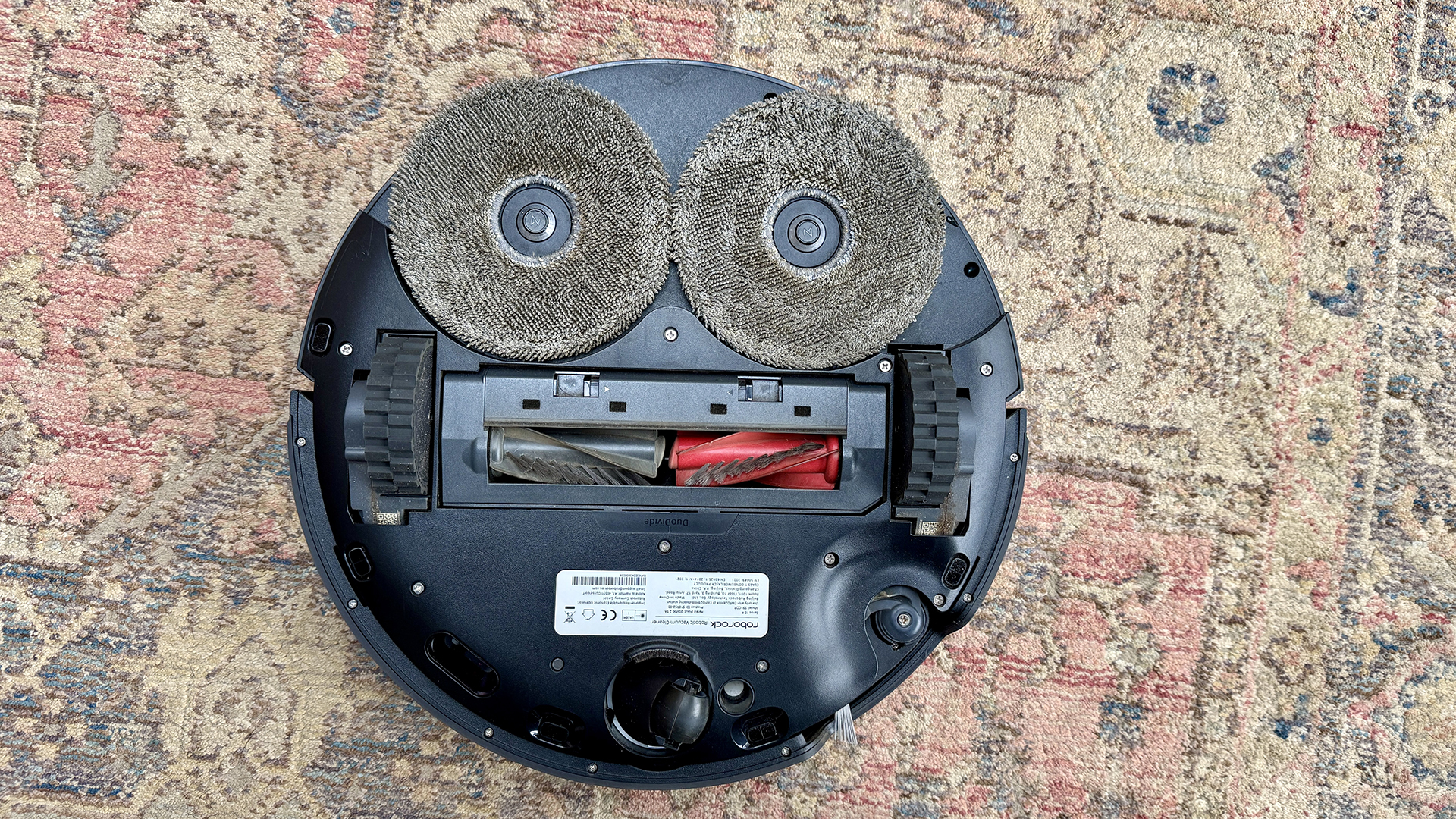
Like the Roborock Qrevo Curv I reviewed a few weeks ago, the Saros 10R can negotiate thresholds, small steps and floor-mounted tubed furniture legs up to 0.39 inches (1cm) in height. However, the Qrevo Curv's chassis can raise much higher so consider that machine instead if you have tall thresholds.
I'm personally not a big fan of robot vacs that also wet mop the floor, but that seems to be the 'in' thing these days, especially when it comes to the mid-to-upper range of robot vacs. Sure enough, this one comes with a full bells-and-whistles mopping system.
Like most modern hybrid robot vacs, the Saros 10R uses twin spinning mop pads for cleaning hard floors and, like the Qrevo Curv and some Dreame bots, the right-hand side mop articulates outwards for edge cleaning along skirting boards and around furniture legs. Similarly, the mops lift by 10mm when traversing carpets. However, since the mops are attached magnetically, they can also be left in the dock whenever the robot is assigned to a vacuum-only task so that there is zero chance of a damp mop running over even the shaggiest of rugs and carpets.
You get three levels of water flow with this model's mopping system – low, medium and high – but I would suggest sticking to low if used on wooden flooring. Furthermore, I can't vouch for the safety of using this model – or any other hybrid bot for that matter – if your floors are made from delicate laminate since thin laminated flooring is easily warped if water seeps into the joins. (Here's more on how to clean hardwood floors.)
Like the vast majority of Roborock robot vacs, this one also offers its own built-in voice control, if that is your wont. What's more, the voice control continues to work even if your internet system is offline. Alternatively, you can program it to respond to Google Home and Amazon Alexa prompts. Likewise, the robot itself has a voice and it will often pipe up to let you know what it's doing before and after a task, including announcing when it's about to empty its bin into the dock's larger dust bag.
All robot vacs I've tested have either used Chinese or American-accented voices, which is fine. However, with this model – indeed all Roborock models – there's also the option to download British-accented voices (male or female) which makes ownership in the UK a little more personalized.
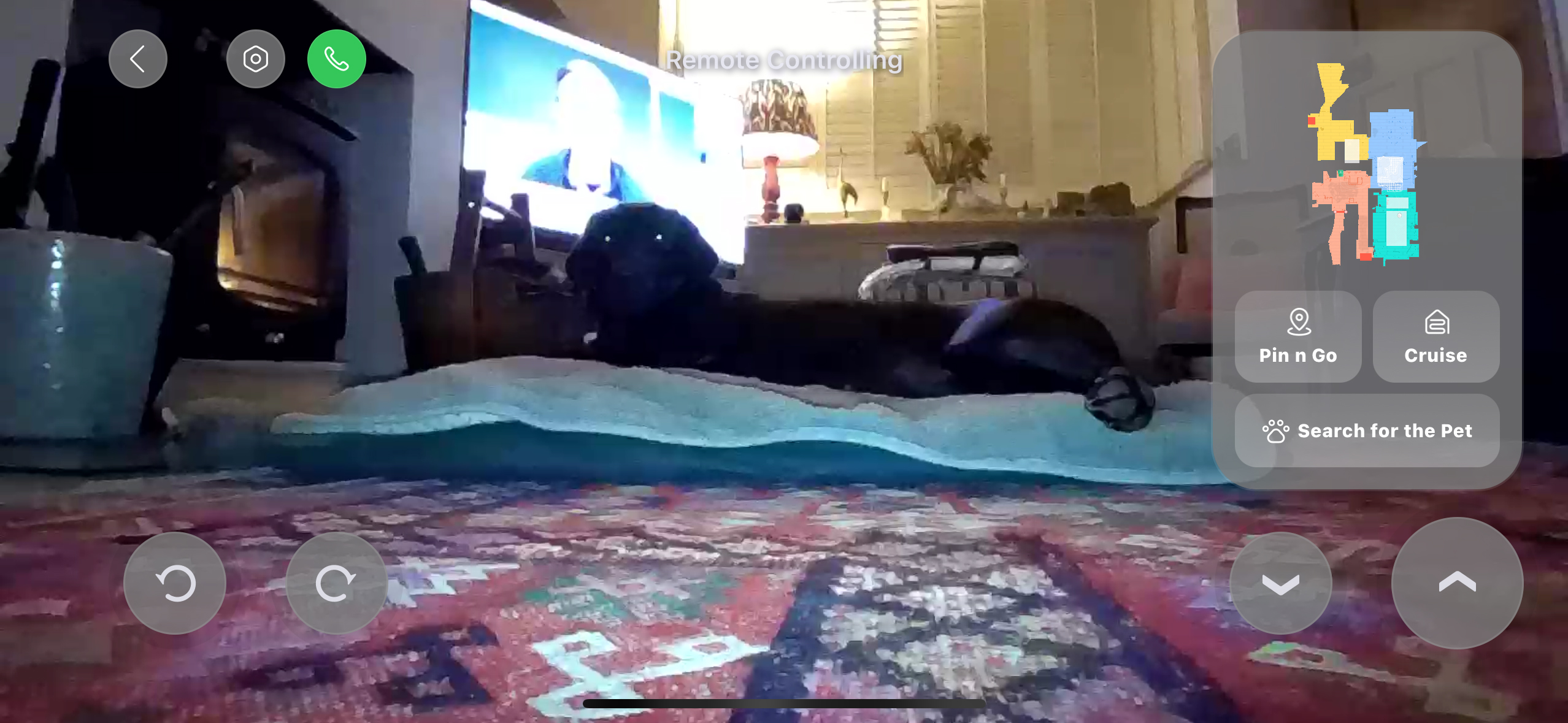
As if you haven't already absorbed enough details for one day, the Saros 10R also provides some cool tech for your pets. For instance, you can remotely drive the robot around like an RC car or select Pet Search and it will look for your dog, cat or gerbil and take a picture of it. You can also use its built-in microphone and speaker to chat with your furry friends, but I would practice this first while you're at home in case they freak out the first time you use it remotely.
Dock design
I recently wrote a feature on robot vac innovations I'd like to see and chief amongst these was a request for better looking robot docks that you wouldn't mind having in the sitting room if space elsewhere was limited. By bizarre coincidence, this model arrived a week later sporting a cleaning dock embellished with a tempered glass front fascia replete with a stunning black mirror finish that reflects its surroundings – especially wooden floors – so well that you hardly notice it sitting there. Thank you Roborock.
At 18.7" (47.5cm) in height, 15" (38cm) in width and 19" (48.8cm) in depth (if you include the ramp), the Saros 10R's charging and self-cleaning dock isn't especially small, so you will need to find an adequate spot to locate it with several inches of space on either side so the bot can dock without difficulty.
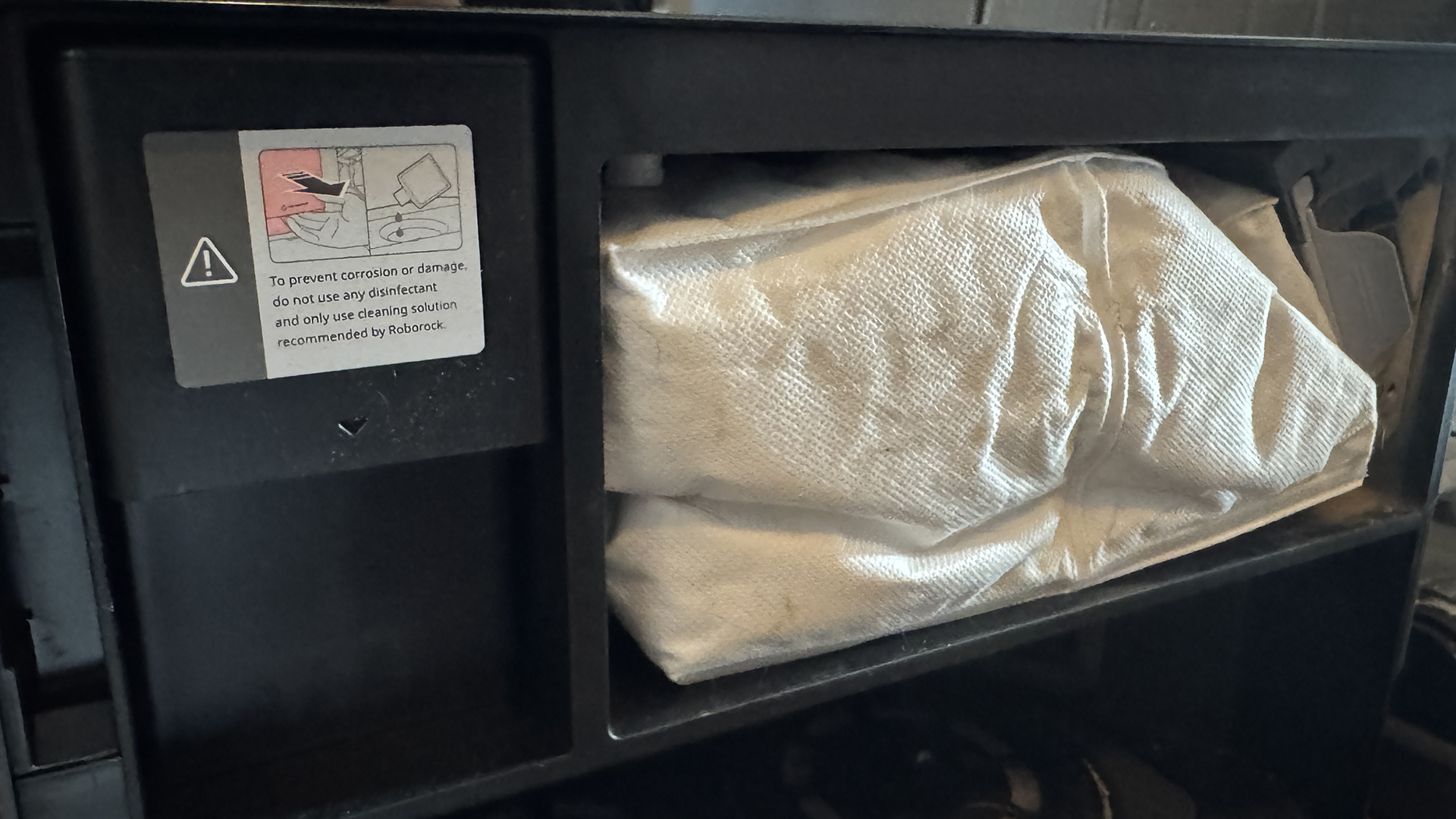
Like most modern hybrid robovacs, the Saros 10R's dock will automatically empty the contents of the robot's small 270ml bin into its much larger two-liter dust bag every vacuuming session and sometimes mid task if requested to do so in the app.
For the mopping system, it comes with two water containers – 3 liters for clean water and 3 litres for the dirty stuff – which you will have to attend to from time to time by simply emptying the dirty water into a sink or toilet and topping up the other tank with fresh water. This model also comes with a detergent dispenser that can be filled with your own choice of hard floor detergent, though Roborock, like any floor cleaning product manufacturer, will naturally advise against this so you're persuaded to buy their own brand.
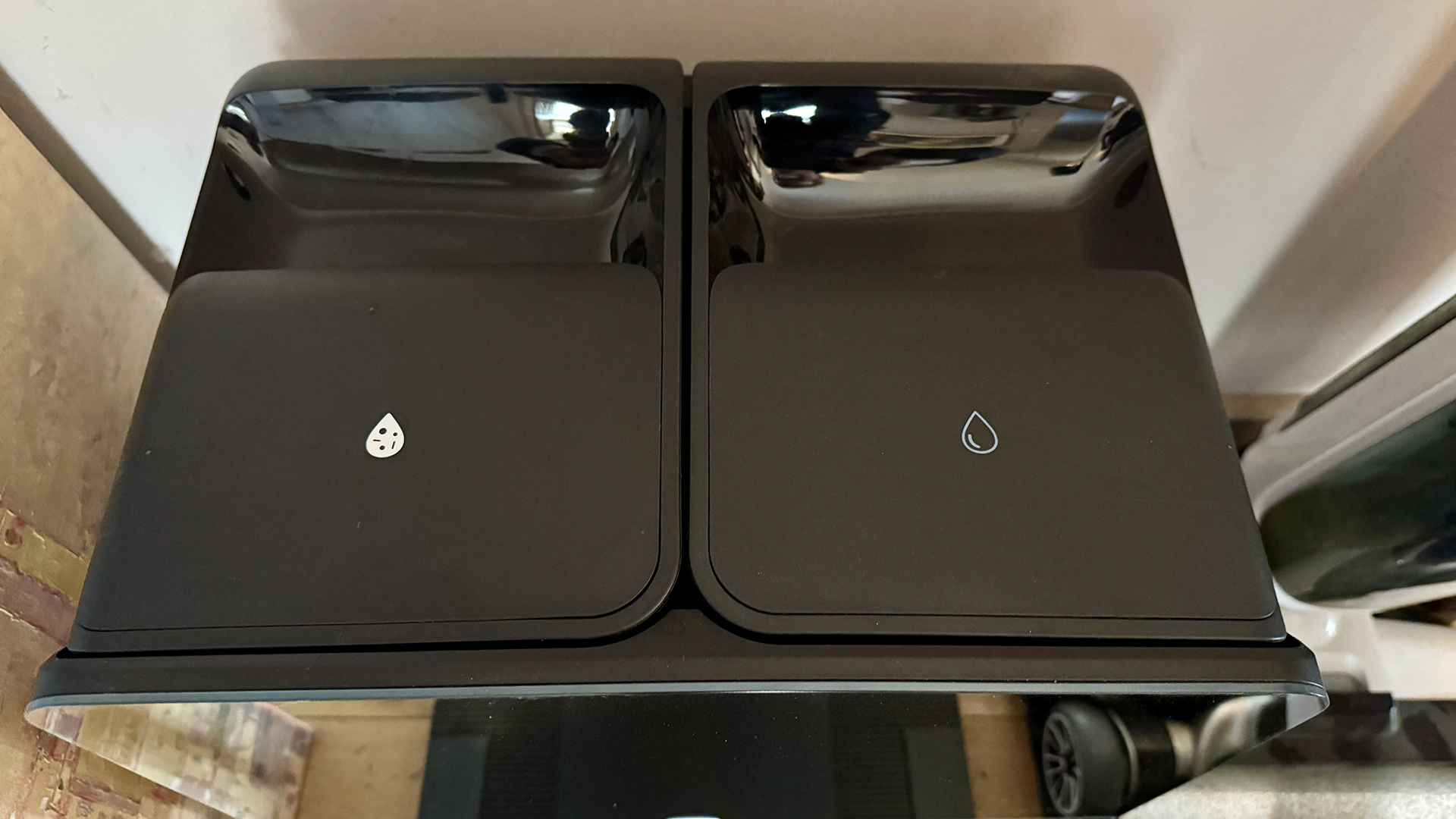
There's no shortage of sci-fi tech in this dock when it comes to cleaning the mops. On returning to the dock after a mopping run, the dock's scrubbing mechanism washes both mops using hot water at a very effective 176F (80C). If its intelligent dirt detection system senses excessive dirt in its cleaning tray, it will rewash the mops to ensure near perfect cleanliness for the next session. It will then proceed to dry the mops using wafts of warm air at 131F (55C). When it's time for its next mopping mission, the dock will automatically fill the robot's small water reservoir with warm water for improved stain removal.
Some docks I've seen also come with a self-cleaning feature that injects water into the mop tray. However, in most instances you need to get down on your knees with a brush to help move the dirty water towards a suction tube. By contrast, the Saros 10R's self-cleaning system does it all for you by scrubbing the tray in hot 176F (80C) water before porting the dirty stuff up a small pipe positioned at the rear. To activate the self-cleaning function, simply go to Dock Settings in the Roborock app and select 'Self-Cleaning for Cleaning Tray'. I should add that it's worth checking the cleaning tray from time to time to remove any excessively large pieces of debris that are sometimes collected by the mops and the robot's brush rollers. The two-part tray is easily cleaned with a brush and some hot tap water.
If you have a smart modern kitchen and you like your appliances to be fully integrated, you can also request this model as a svelte plumbed-in version that automatically fills the fresh water tank while emptying the contents of the dirty water container into a drainage outlet.
- Design score: 5 out of 5
Roborock Saros 10R review: performance
- Industry-leading navigation
- Great vacuum performance
- Excellent dock functionality
There's a lot to get into on the performance front here, so I've broken this section up into sub-sections. I'll start with that pioneering navigation, then look at obstacle avoidance, vacuuming performance (including the results f our suction tests), mopping performance, and finally dock performance.
Navigation performance
As mentioned above, the Roborock Saros 10R uses StarSight to navigate, an innovative system comprising a turret-free LiDAR, front-facing RGB and infrared cameras, and all sorts of other sensors to help it maneuver through even the most complex of floorspace layouts.
I've had it running for the past few weeks and at no point has it failed to find its dock or simply stopped mid-task for no reason. Mind, that's been the case with most Roborock models I've reviewed. Its mapping is exemplary and you can watch it all unfold in real time on the app's map screen.
Like a whirling dervish, it trundles off on its mapping run – an advised process when using it for the first time – and completes the task with impressive speed. In fact it took just five minutes for it to map my open-plan living space comprising five different areas. Yes, it merged two areas together as one room but even that was easy to rectify, simply by going into the app and dividing them into two separate rooms.
One of the most common anomalies with LiDAR-equipped robot vacs is their refusal to punch through a bed or sofa valance. This is because LiDAR treats a fabric valance as a solid boundary. Well I'm pleased to say that the Saros 10R is the first LiDAR-equipped robot vac I've ever tested that's capable of penetrating the valance on my lounge sofa.
Rather confusingly, it doesn't do it every time it's vacuuming the lounge so perhaps it's something to do with its angle of approach at the time. That's the thing with robots; they sometimes behave in mysterious ways. Either way, I'm very happy with this discovery.
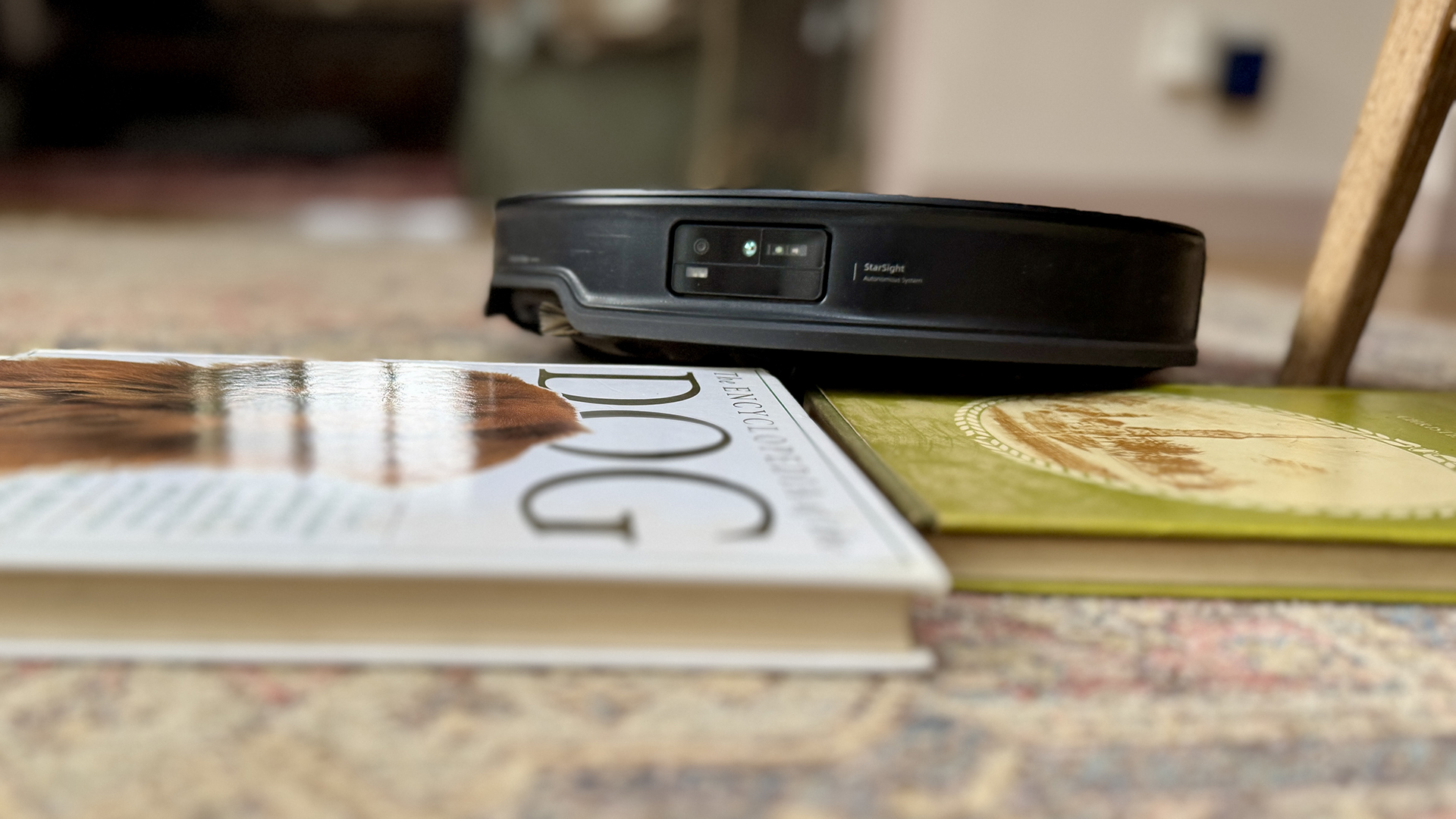
I also tried to replicate a threshold using books but the Saros 10R isn't designed for anything much higher than 0.39 inches (10mm). Unlike the Roborock Qrevo Curv, which scaled the same book experiment like an off-road tank, the Saros 10R made an attempt to ride over the books but then thought better of it and retreated. Hence, if you have tall thresholds up to 1.5" (4cm) in height, Roborock's Qrevo Curv model would be a better bet.
Obstacle avoidance
Most robot vacs I've tested haven't been that great at small obstacle avoidance, especially when the objects have been less than an inch and a half in height. Sure enough, the Saros 10R at first refused to recognize one specific obstacle – a one inch-high nylon dog bone that's been too low in height for most robot vac's cameras and obstacle sensors to detect. Like the majority of bots, it basically rode over the bone and then struggled to extricate itself by moving hither and thither while one of its wheels raised the whole unit up in the air at a cock-eyed angle.
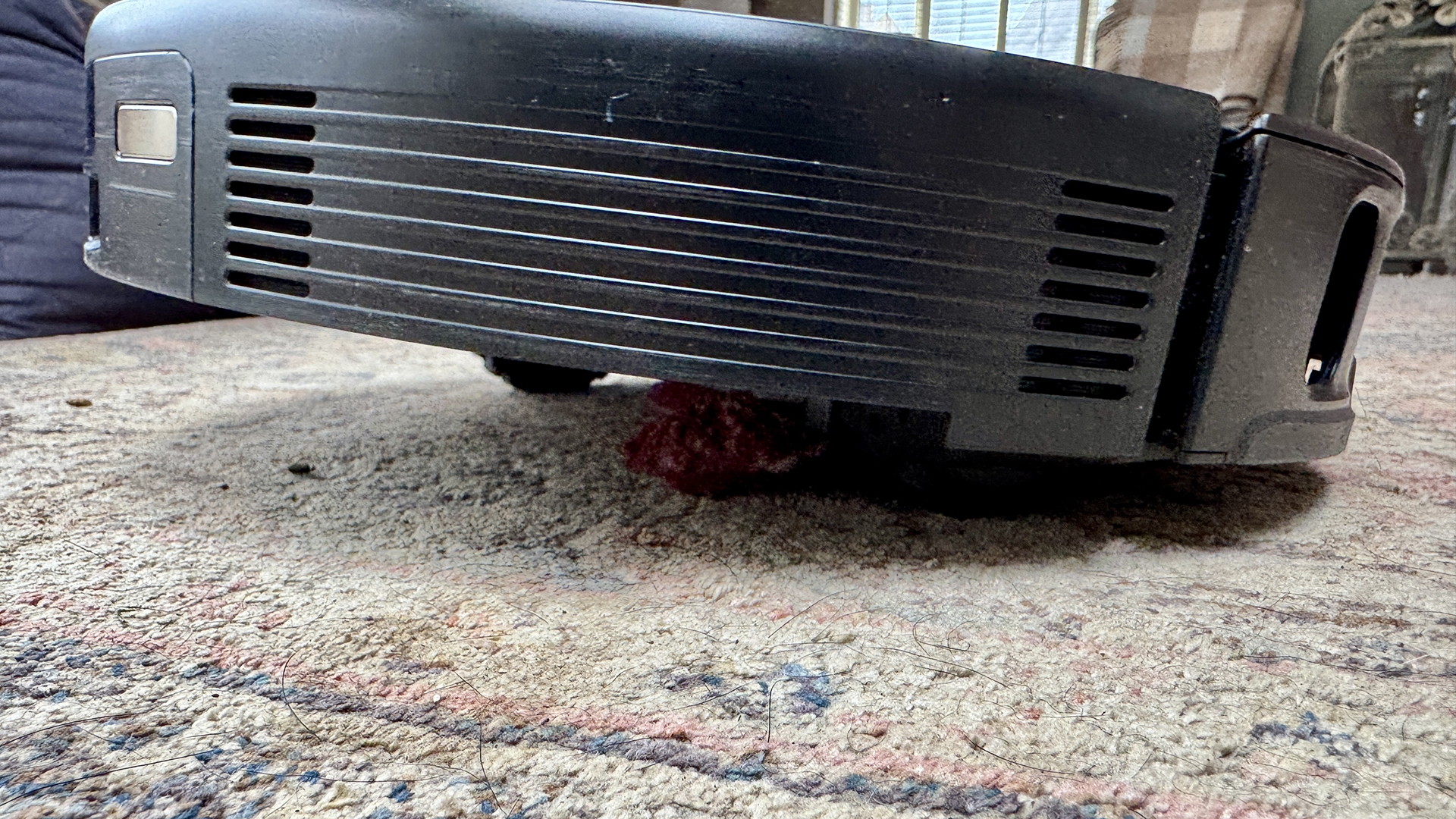
I checked the Roborock app to see if I'd missed a setting and, lo and behold, I discovered that I hadn't activated the 'Pet' option that 'recognizes and avoids pets and their waste with precision'. I remember seeing this option when I first set it all up but the 'avoids pets' explanation sounded unnecessary to me, since most pets are larger in size than any small obstacle. So I originally left the option off. In hindsight, I think this function in the app needs to be amended to just say 'avoids pet waste' to circumvent any confusion, because once I'd activated it the Saros 10R became a different beast altogether.

In fact, it consistently avoided said bone every time I dropped it in its path. Sometimes it would avoid it by about six inches and other times come perilously close but deftly work its way around it. I should add, however, that it may not clean as closely to the object when the pet option is selected. Swings and roundabouts spring to mind. Would I rely on this model to reliably avoid all pet waste all the time? No way, José. I've been down that road already and don't wish to go there again.
Vacuum performance
The Saros 10R vacuums like a trooper and comes with five power bands – from Quiet to Max+. I have my test model set between Max and Max+ since I see no reason to select anything less, given that the bot has enough battery to complete an entire sweep of my home in either of these modes. And besides, even if it were to run out of juice it will simply return for a full recharge – which takes about two and a half hours – before heading out again to complete the task.
Unlike non-LiDAR robots like those from iRobot, this model vacuums in a systematic pattern that makes a lot of sense, especially when you're watching it work. I also like the way the side brush pops out of the casing whenever the robot approaches a corner. It does a fine job of flinging debris into the path of the roller brush. This brush also lifts off the ground when the robot is vacuuming rugs.
Aside from its generally excellent suction performance, a quick shout out to the developers for coming up with such an effective two-piece corkscrew-shaped brush roller because at no time has any pet tangled on it. Instead, any hair is cleverly coaxed towards a centre gap between the rollers and into the mouth of the suction area. In this regard, I can wholeheartedly recommend this model as one of the best robot vacuums for collecting pet hair.
For my hard floor vacuum test I scattered raw oats, flour and half a crushed Hobnob biscuit and set it to clean a small zone in the kitchen using the Max setting and two passes for good measure. As expected, the robot disengaged its mops in the dock and headed straight to the specific area I drew on the map. It duly sucked up all the larger pieces of detritus but did leave traces of flour in the floor seams.
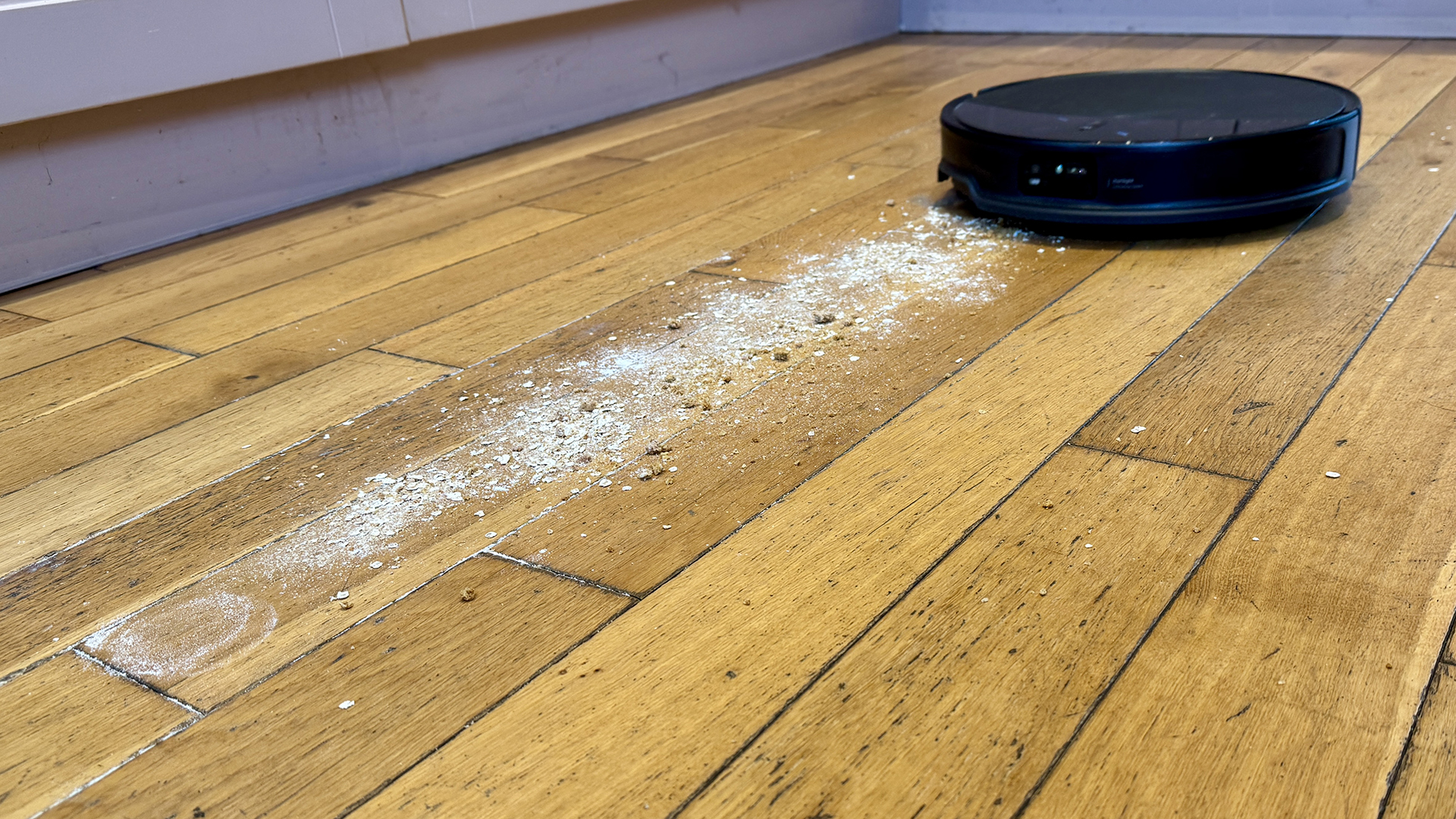
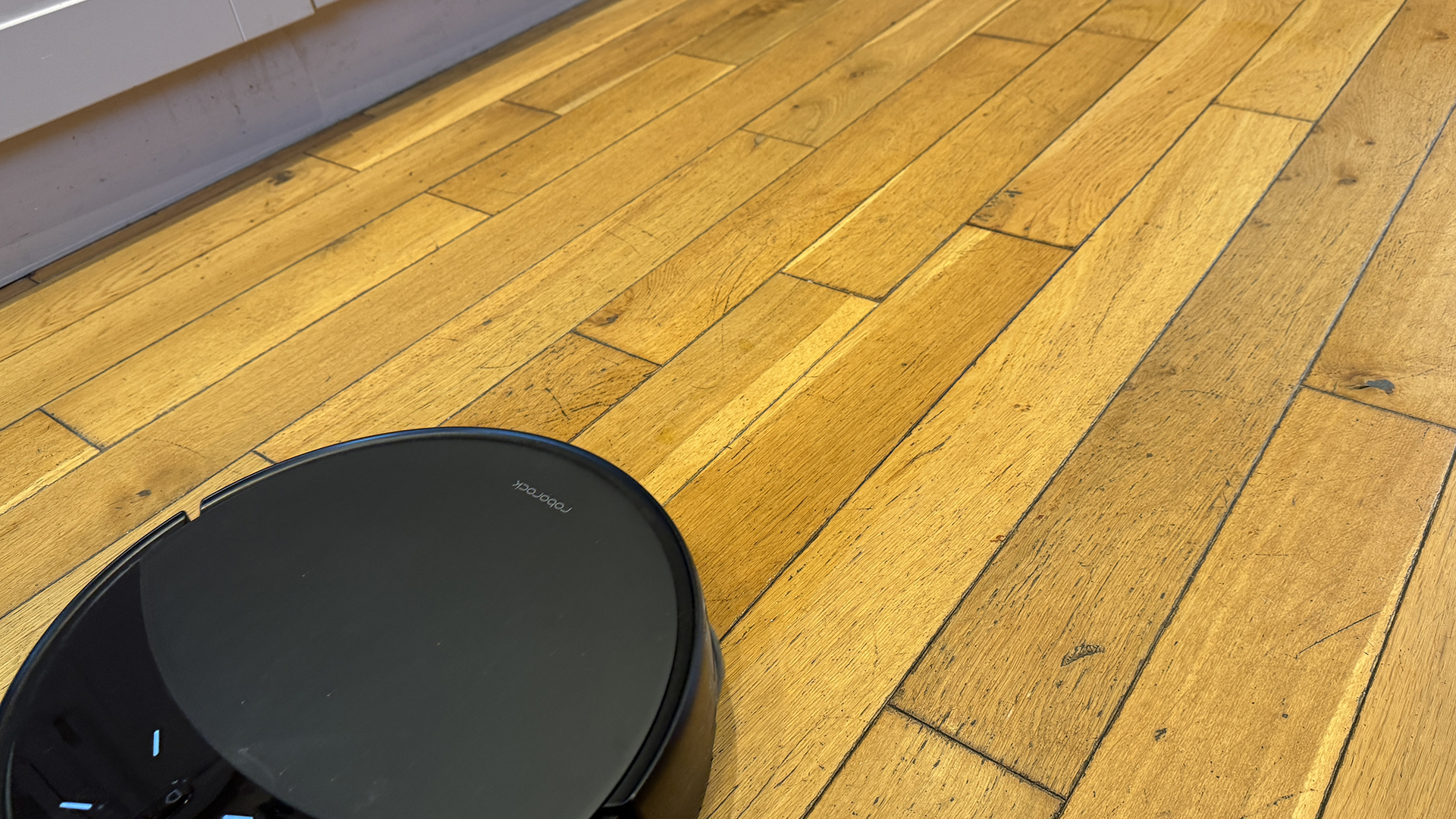
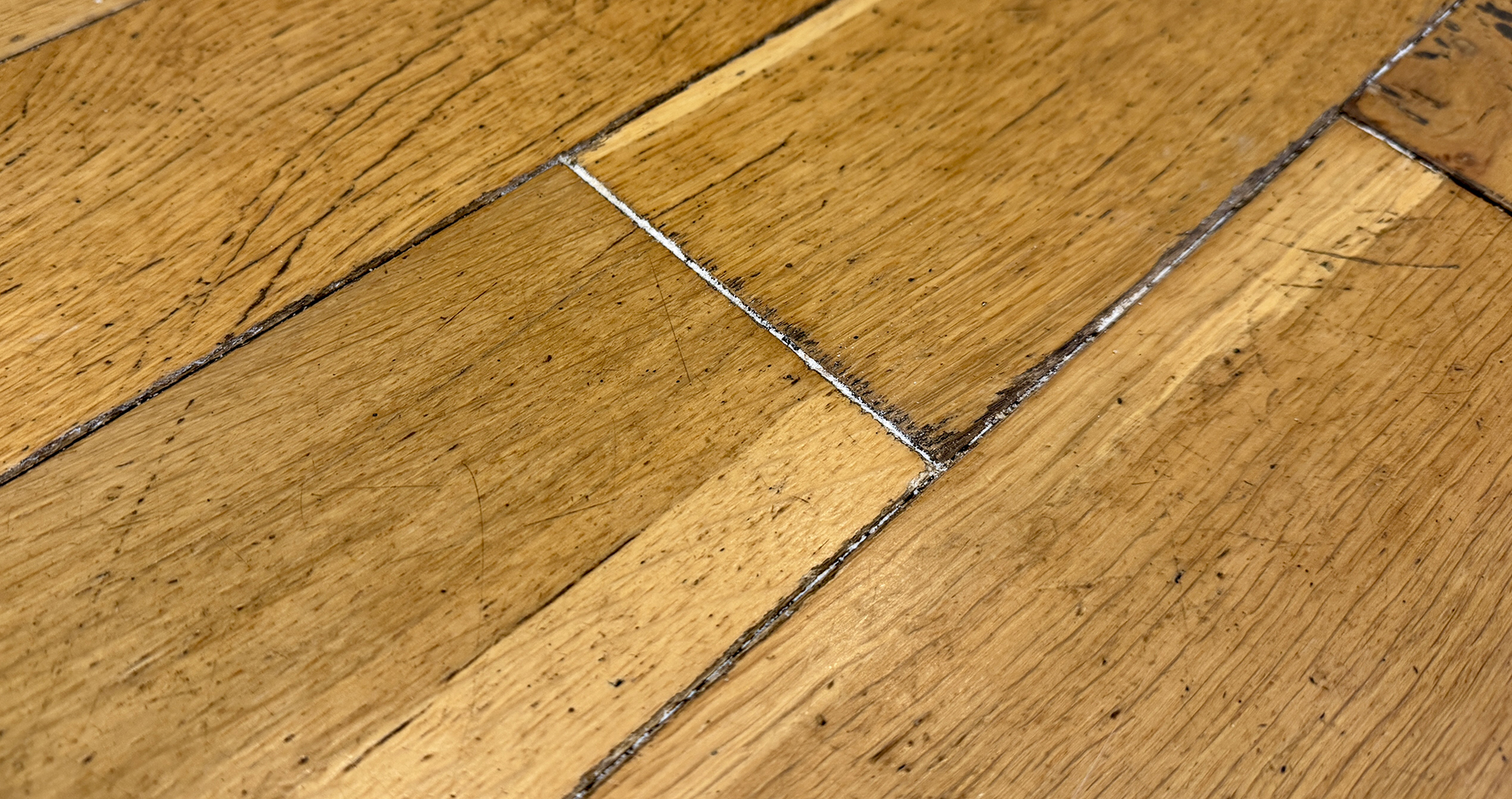
So I reprogrammed the test, this time using Max+ mode and it collected a bit more flour than before but still left some evidence in the cracks. I personally don't consider this a fail because no robot I've tested has ever completely removed flour from the joins in my wooden flooring. And anyway, in the real world one wouldn't rely on a robot vac to perform a one-off sweep of a specific area when you should, by rights, have a cordless stick vac to hand.
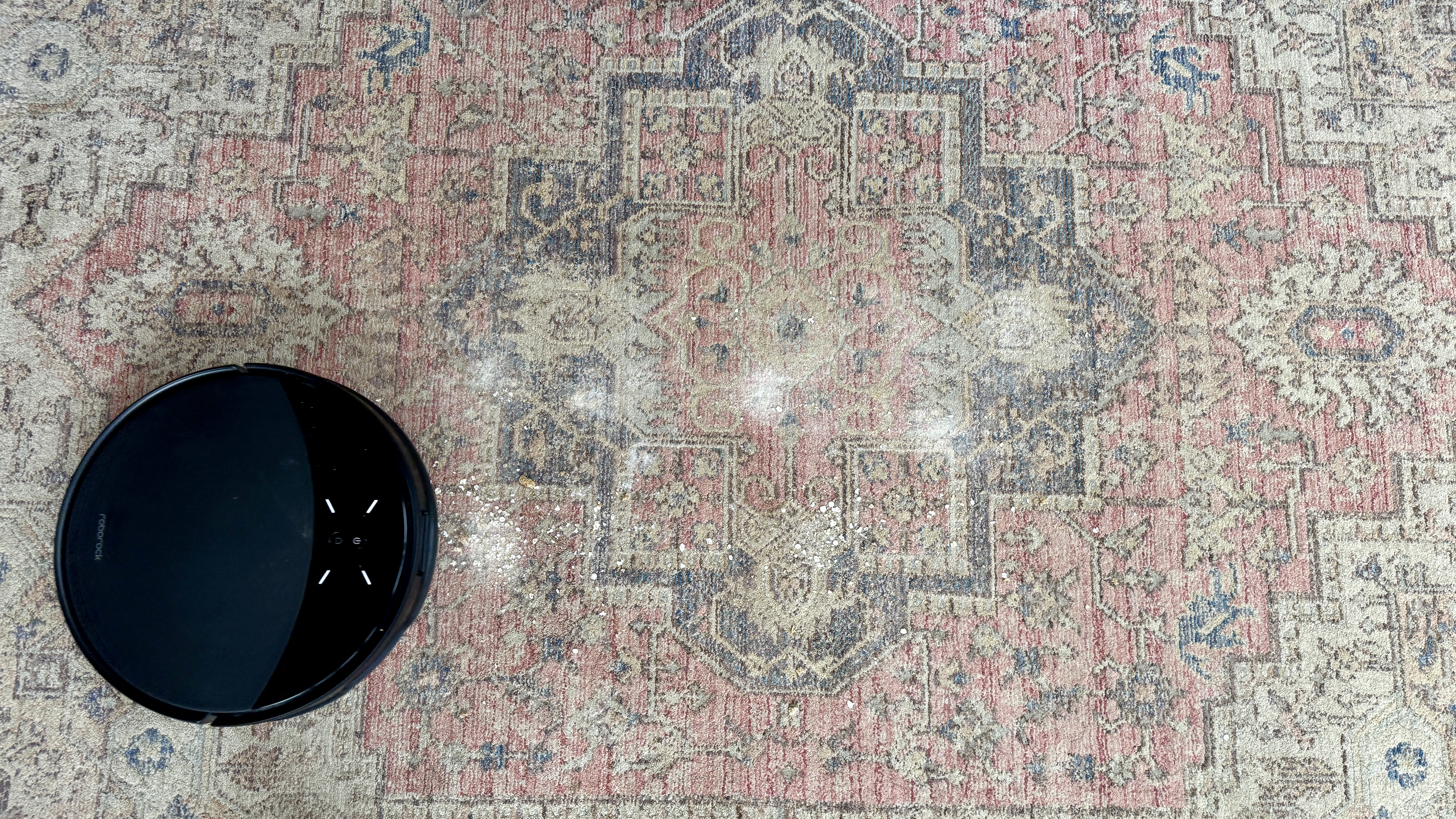
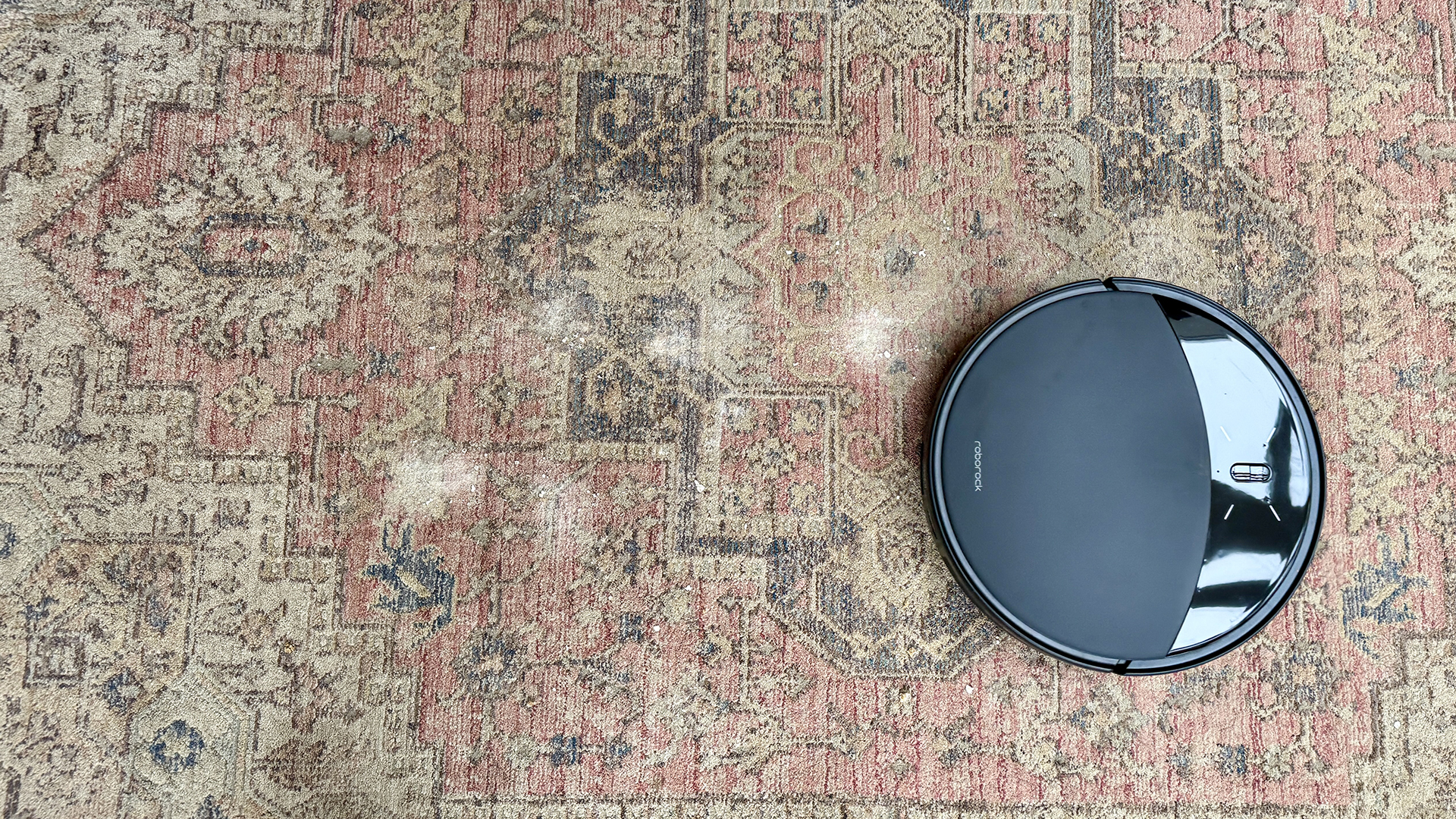
Test two involved the same ingredients on the medium pile rug I have in front of the dogs' beds, with the Saros 10R set to Max+ mode and two passes. Aside from some light evidence of flour on the rug that was easily finished off by the Dreame R20 stick vac I recently reviewed, I still rate this test a success. I was especially impressed with the way it moved both vertically and laterally across the rug to ensure full coverage.
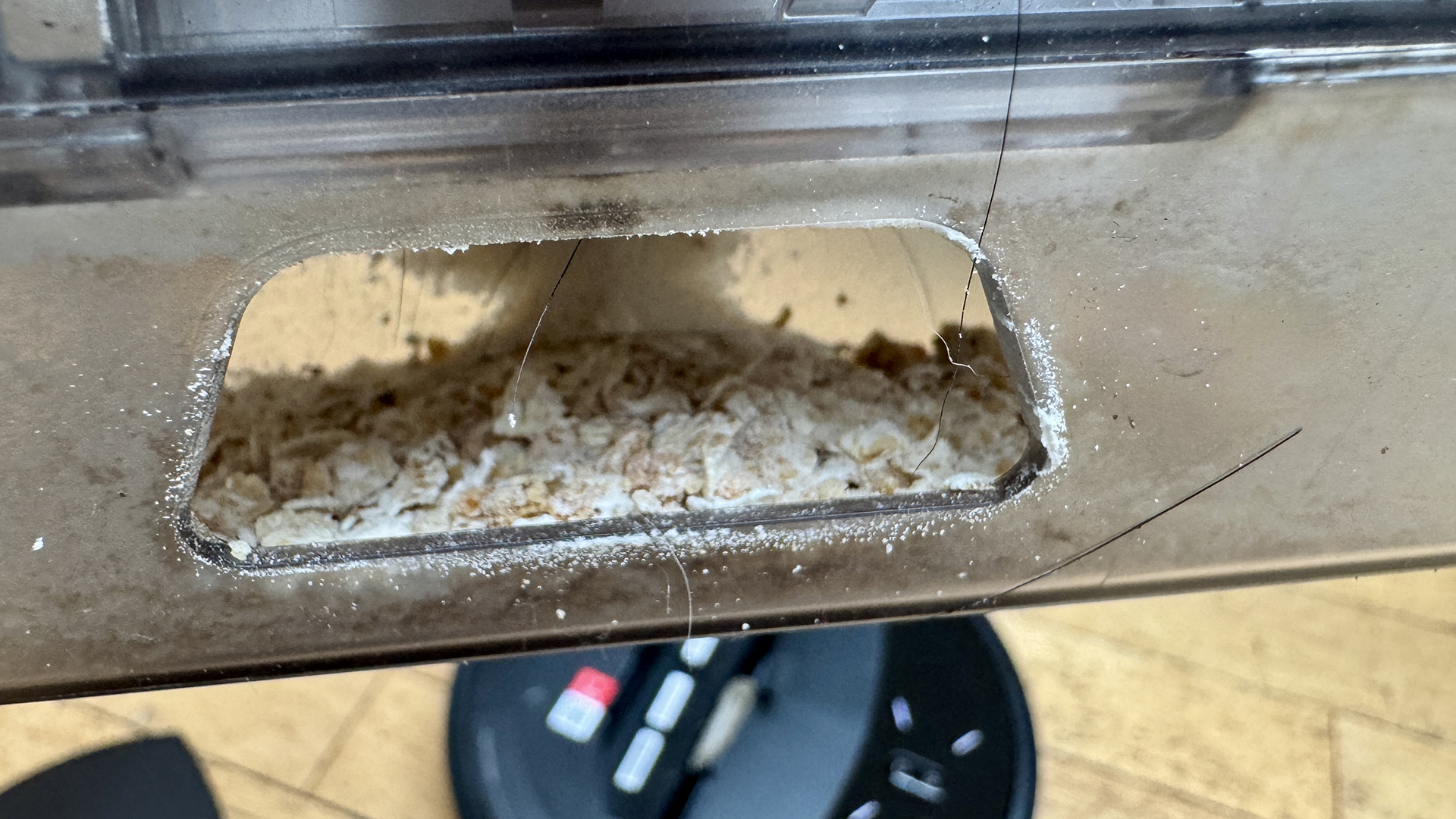
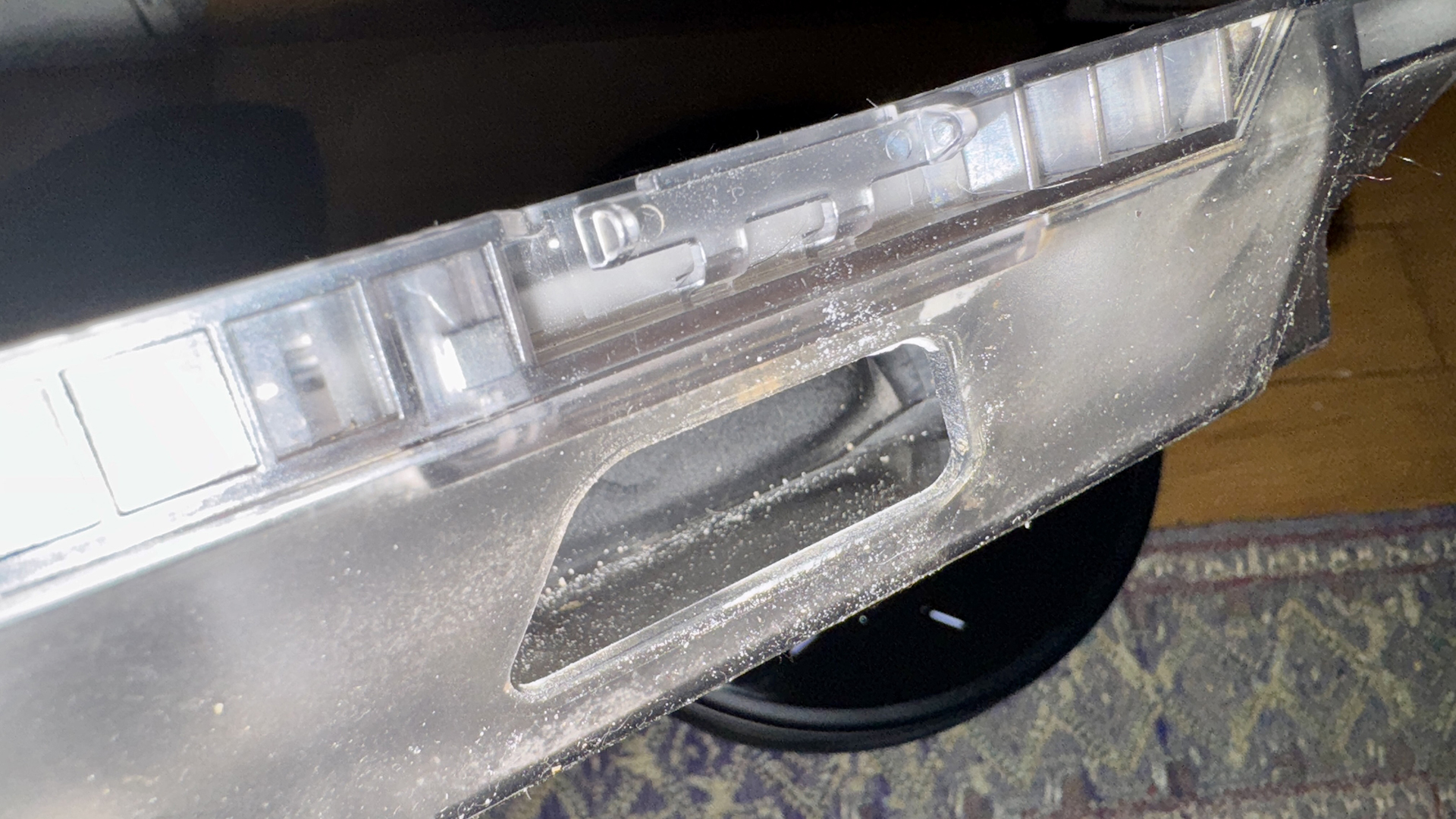
Finally, big props to Roborock’s technical team for creating one of the quietest robot vacs in the business. With a reading of 55dB from 10 feet away, this thing is amazingly quiet, even in Max mode. And best of all, its sound frequency occupies the lower portion of the spectrum so it doesn’t sound annoyingly shrill like some of the competition. In fact, when it’s working in an adjacent room you can hardly hear it at all.
Mopping performance
As I've mentioned above, I'm not a fan of mopping robots, mostly because I'm lucky enough to have a cordless wet-and-dry hard floor cleaner which I find is more than enough for occasional mopping duties. Nevertheless, the industry seems to have decided that mopping is what people want so, along with observing its bi-weekly mopping runs, I also put this model through a specific mopping test in the kitchen.
Using a hotchpotch of wet ingredients – soy sauce, syrup and a teaspoon of milk – and a pre-set zone routine in the app using the low water setting, the Saros 10R's dock filled the unit's small onboard water container with a mix of warm water and detergent, and primed its two spinning mops. It then trundled off to its predetermined zone.
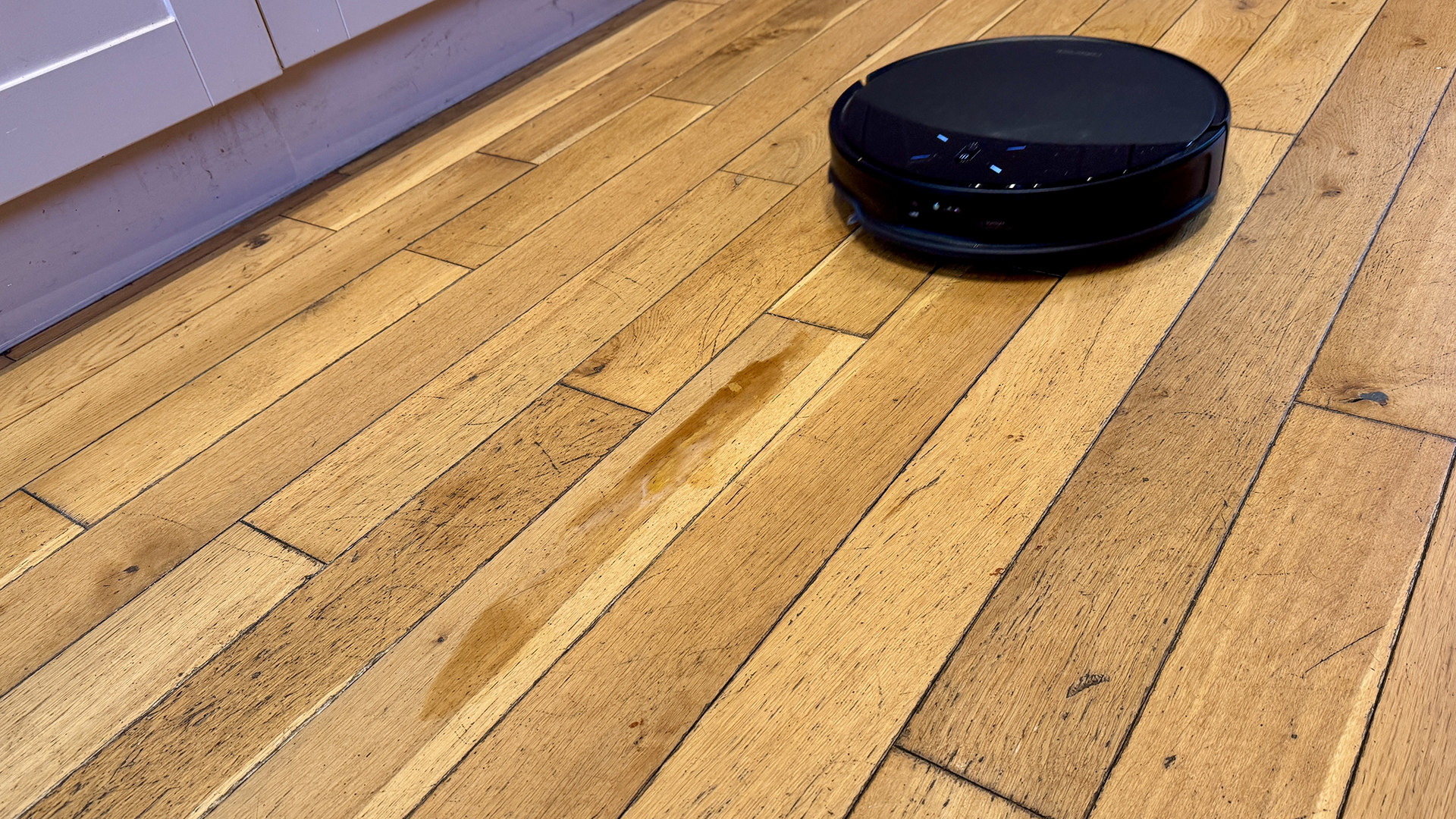

Well blow me down with a feather if it didn't clear the floor of all evidence in a single sweep. This really impressed me because I at least expected to see a smear of syrup. That's a fine result in my book.
Dock performance
I've only had one minor issue with the dock and it occurred directly after a family Christmas with five dogs and three cats in attendance. Once everyone had gone home, I unboxed the Saros 10R and set it to work in the lounge. This room hadn't been swept for three days and the Christmas tree had dropped a lot of pine needles.
Cutting to the chase, the unit duly swept up as well as anyone could reasonably expect from a high-performance model of this nature but when it proceeded to dump the contents of the robot's bin into the dock's large 2-litre dust bag, the hair clogged up the works. A quick check of the robot's bin showed an enormous conglomeration of pet hair and pine needles protruding from the bin's outlet port and another clump that had blocked the inlet tube leading to the dock's dust bag.
I should add that every robot I've tested has had at least one issue like this – and even my Dyson Gen5detect has jammed up from time to time – so I put it down to rare circumstances and a combination of matted pet hair and pine needles. I'm personally not sure if the Saros 10R's dock suction is as strong as the Qrevo Curv's because it sounds quieter, which is a good thing. Nevertheless, I'm very pleased to report that the dock has experienced no further problems during the past four weeks I've been using it.
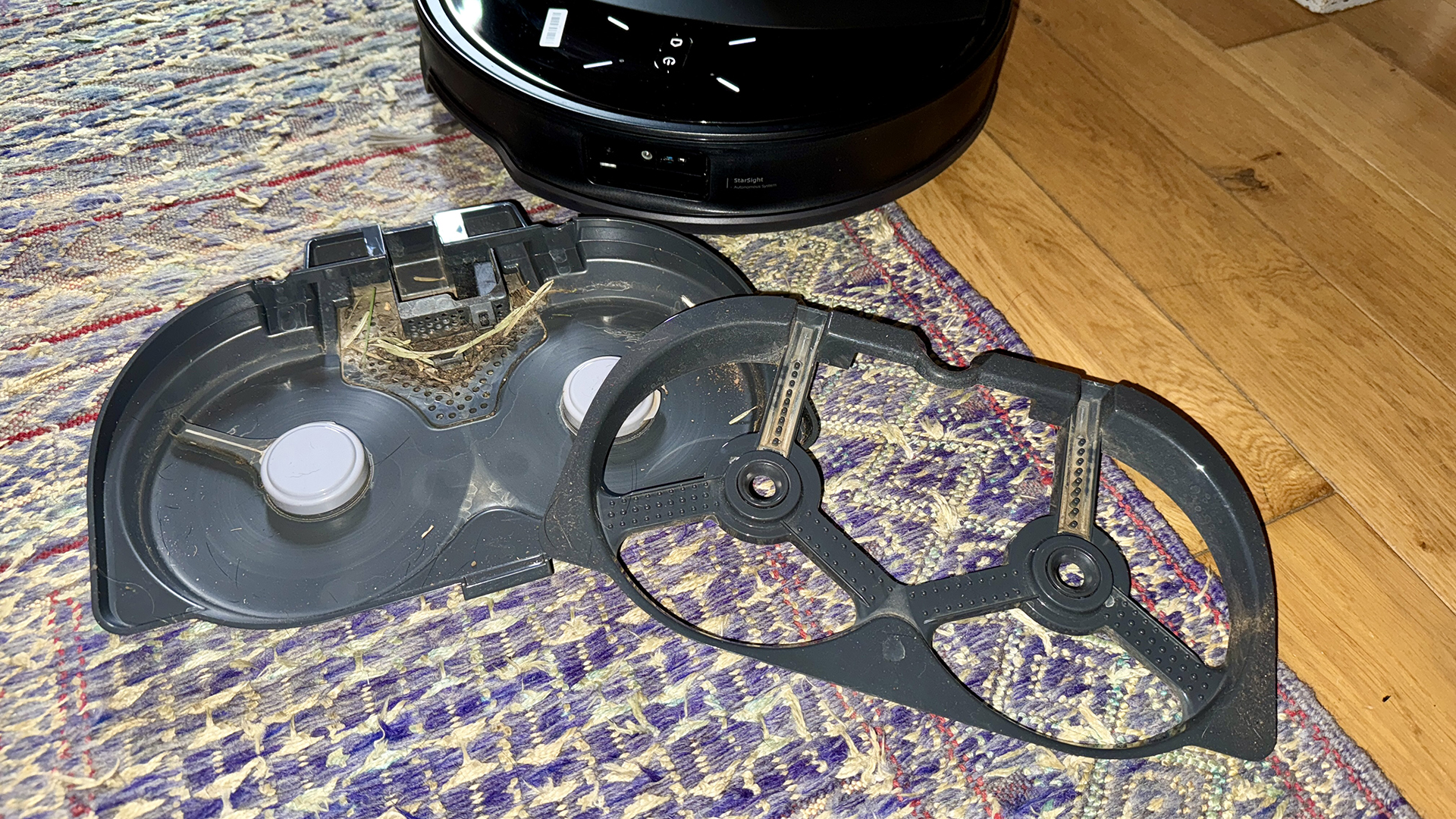
In terms of self cleaning the mops, it did them well enough in my opinion given the amount of muck on the floor. However, I would always advise removing them and giving them a good scrub under a hot tap with some washing-up liquid for good measure. By the way, I especially liked the way the dock cleaned the mops' tray using water and a revolving mechanism to sweep the dirty stuff towards a small rubber suction tube.
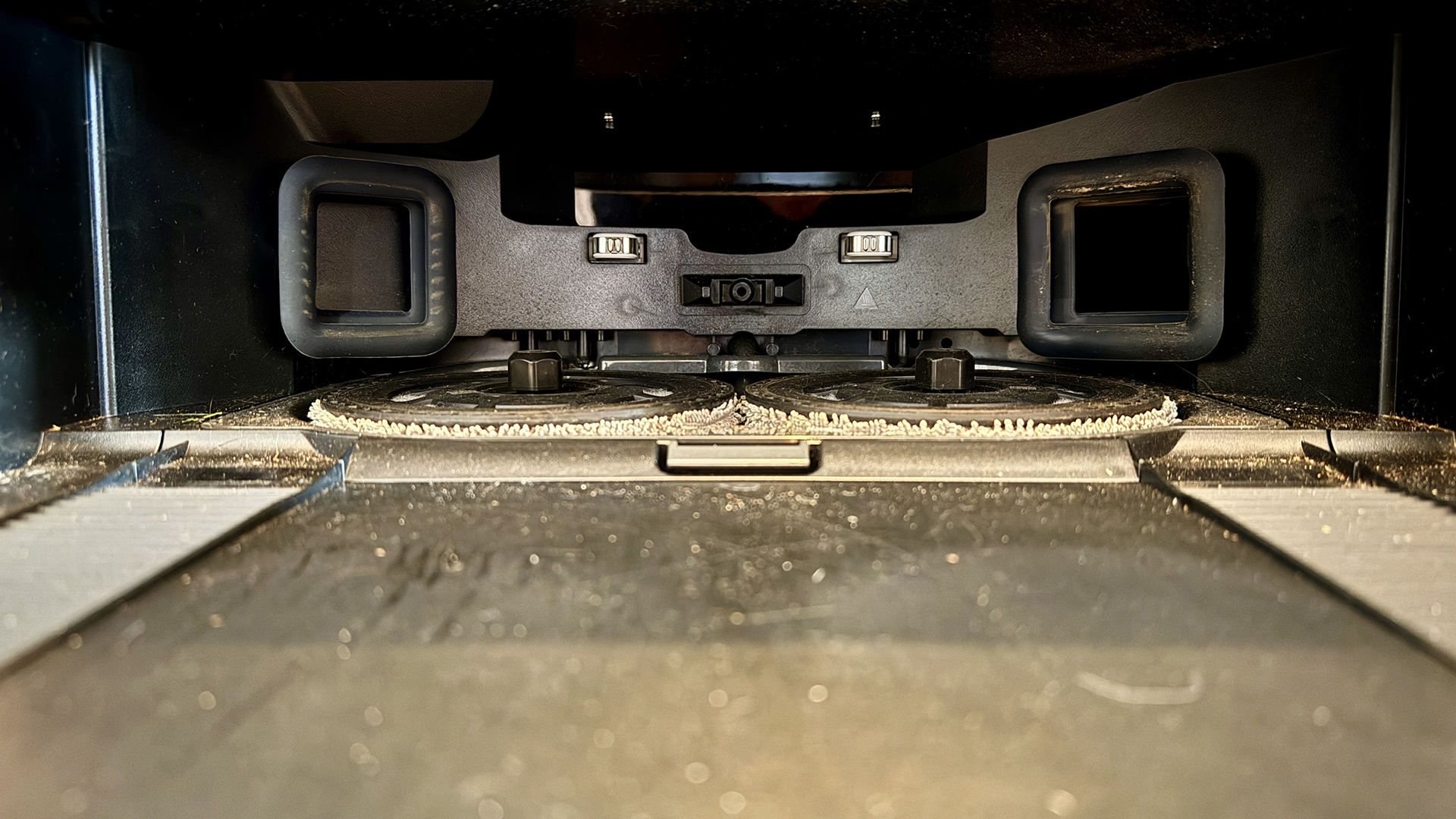
Although Roborock advertises up to seven week's worth of floor matter collection before its dust bag requires binning, I am having to change the bag every three weeks – but then I do have a large menagerie of furry creatures. Hence, I'd like to see some bigger dust bags going forward.
In conclusion, I have been really impressed with this robot vac's overall performance and I find it hard to give it anything less than five stars in this category. It's just so reliable and efficient at the tasks it was designed to do.
- Performance score: 5 out of 5
Roborock Saros 10R review: app
- User friendly
- Superb customization
- Impeccably clear maps
Judging by the Reddit forums, I'm not the only one to think that the Roborock app is the best on the market. This app is just so customizable, intuitive and informative to use. Firstly, it produces a highly detailed map of the home with evidence of every nook and cranny. And you can edit the map to your heart's content, whether that's dividing or merging rooms, or adding keep out zones and virtual barriers. Aside from being able to create an endless range of timed schedules, you can also assign specific zones you want cleaned on a frequent basis, and save them as routines that appear on the home screen for convenience.
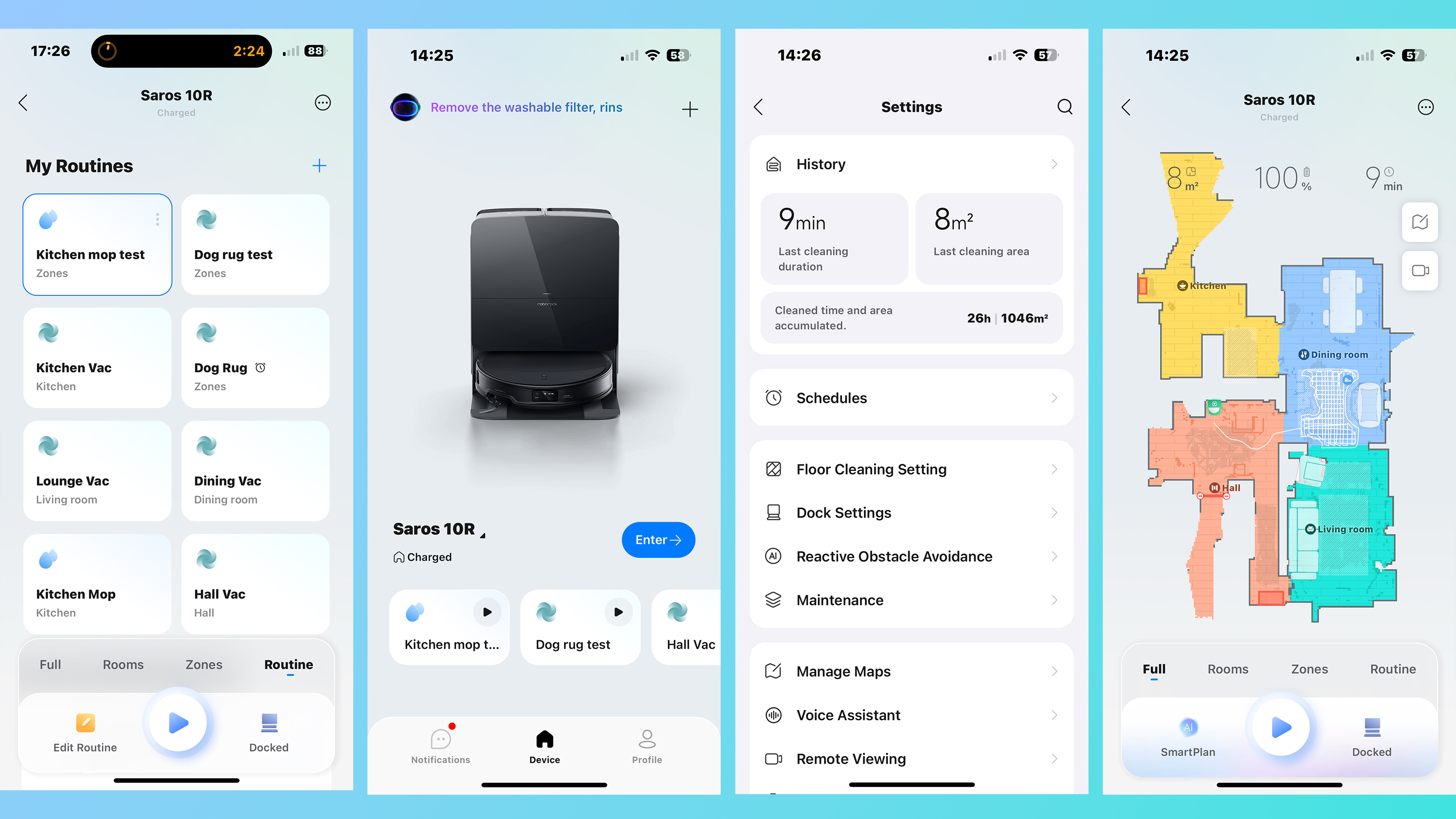
The app also offers something called SmartPlan as an option when cleaning. This feature supposedly weighs up the tasks it's previously performed and adjusts its cleaning method accordingly. Hence, if, say, the robot mopped the kitchen yesterday it might avoid doing it today. I personally leave it off since I don't want it doing anything I don't want it to do.
This app also features a full smorgasbord of custom features, including settings for floor cleaning, the dock, the robot's reactive obstacle avoidance, maintenance, remote viewing, robot settings, the list goes on. Furthermore, each menu you select brings up a range of individual tweaks with explanations that you could spend many happy hours fiddling with.
- App score: 5 out of 5
Should you buy the Roborock Saros 10R?
Attribute | Notes | Rating |
|---|---|---|
Value | Premium in price, but justified by the extensive features and state-of-the-art technology. | 4 / 5 |
Design | Exquisite design flourishes throughout, and with the smartest looking dock in the business. | 5 / 5 |
Performance | Expert navigation, above-average obstacle avoidance and superior floor cleaning on both hard floor and carpet. | 5 / 5 |
App | There's no better robot vac app for UI and deep customization. | 5 / 5 |
Buy it if...
You want unbridled efficiency
This bot performs all tasks with consummate skill.
You want hands-free operation
The Saros 10R's self-cleaning features are a key selling point – the dock will not only empty the dust cup and wash and dry the mop pads, but clean itself too.
You need versatility
This bot is designed for complex environments – layouts with a mix of floor types and lots of obstacles.
Don't buy it if...
You're on a budget
The Saros 10R is expensive with a capital E. And while the premium features and tech help justify that asking price, if you don't need the very latest tech then there are plenty of options that'll do a very good cleaning job for a lower price.
You have very tall room thresholds
While the Saros 10R is pretty good at getting over raised thresholds, it's not as good as the Roborock Qrevo Curv.
You don't require a mopping function
Mopping (and the related mop dock functions) bump up the cost of this model considerably, so if you're not fussed about that then look for a vacuum-only model and save some cash.
How I tested the Roborock Saros 10R
I received my test model of the Saros 10R just before Christmas and set it up before the New Year 2025. For the following month I ran different daily schedules in both vacuum and mopping modes. It has been one of those robot vacs that just gets on with the job without making a song and dance about it.
However, for purposes of this review, I also put it through three specific TechRadar tests involving both vacuuming and mopping just to make sure it was as efficient as it seemed. As you will have read, it sailed through everything without any major hiccups. I should add, however, that that was the least I expected from a brand which has a reputation for producing great gear that just works.
Read more about how we test robot vacuum cleaners.
- First reviewed February 2025
Derek Adams has been in consumer tech journalism since joining London listings magazine Time Out in the early ‘80s. He’s an experienced reviewer of cordless vacs and robot vacs, indeed anything that runs on batteries or has a plug attached. Derek also writes extensively for TechRadar’s sister site T3.com between playing drums and guitar with his bandmates in Red Box.
You must confirm your public display name before commenting
Please logout and then login again, you will then be prompted to enter your display name.
